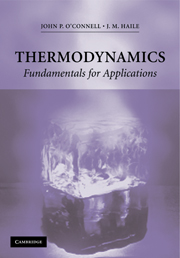Book contents
- Frontmatter
- Contents
- Preface
- Acknowledgments
- THERMODYNAMICS: Fundamental for Applications
- 0 Introduction
- PART I THE BASICS
- PART II SINGLE-PHASE SYSTEMS
- PART III MULTIPHASE AND REACTING SYSTEMS
- 7 Transfers, Transformations, and Equilibria
- 8 Criteria for Observability
- 9 Phase Diagrams for Real Systems
- PART IV ENGINEERING CALCULATIONS
- APPENDICES
- Notation
- Index
9 - Phase Diagrams for Real Systems
Published online by Cambridge University Press: 05 June 2012
- Frontmatter
- Contents
- Preface
- Acknowledgments
- THERMODYNAMICS: Fundamental for Applications
- 0 Introduction
- PART I THE BASICS
- PART II SINGLE-PHASE SYSTEMS
- PART III MULTIPHASE AND REACTING SYSTEMS
- 7 Transfers, Transformations, and Equilibria
- 8 Criteria for Observability
- 9 Phase Diagrams for Real Systems
- PART IV ENGINEERING CALCULATIONS
- APPENDICES
- Notation
- Index
Summary
With many million pure substances now known, an essentially infinite number of mixtures can be formed, resulting in a diversity of phase behavior that is overwhelming. Consider just two components: not only can binary mixtures exhibit solid-gas, liquid-solid, and liquid-gas equilibria, but they might also exist in liquid-liquid, solid-solid, gas-gas, gas-liquid-liquid, solid-liquid-gas, solid-solid-gas, solid-liquid-liquid, solid-solid-liquid, and solid-solid-solid equilibria. That's a dozen different kinds of phase equilibrium situations—just for binary mixtures. For multicomponent mixtures the possibilities seem endless.
In this chapter we describe the kinds of phase behavior that are commonly observed in pure fluids, binary mixtures, and some ternary mixtures. The descriptions typically take the form of phase diagrams, and we show how studies of phase behavior can be made systematic by identifying classes of diagrams. Since we are interested in describing what is actually seen, the mixture diagrams presented in this chapter are plotted in terms of measurables: usually temperature, pressure, composition, or a subset of those. Calculations of phase equilibria necessarily involves conceptuals, and such calculations are discussed in Chapter 10. Here we only describe phenomena.
We start in § 9.1 by giving prescriptions for determining the number of properties needed to identify the thermodynamic state in multicomponent mixtures. Those prescriptions include Duhem's theorem and the Gibbs phase rule as special cases. The required number of properties determines the dimensionality of the state diagram needed to represent phase behavior.
- Type
- Chapter
- Information
- ThermodynamicsFundamentals for Applications, pp. 366 - 418Publisher: Cambridge University PressPrint publication year: 2005



